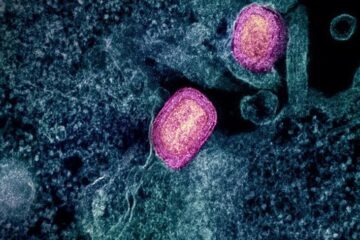On the road to non-toxic and stable perovskite solar cells

The illustration shows the changes in the structure of FASnI3:PEACl films during treatment at different temperatures. Credit: HZB/Meng Li
Halogenide perovskites with tin instead of lead should show excellent optical properties, but in practice, their efficiencies are mediocre and decrease rapidly. And this rapid “aging” is their main disadvantage: the tin cations in the perovskite structure react very quickly with oxygen from the environment so that their efficiency drops.
Now, an international cooperation led by Antonio Abate, HZB, and Zhao-Kui Wang, Institute of Functional Nano & Soft Materials (FUNSOM), Soochow University, China, has achieved a breakthrough that opens up a path to non-toxic perovskite-based solar cells that provides stable performance over a long period.
They also use tin instead of lead but have created a two-dimensional structure by inserting organic groups within the material, which leads to so-called 2D Ruddlesden-Popper phases. “We use phenylethylammonium chloride (PEACl) as an additive to the perovskite layers.
Then we carry out a heat treatment while the PEACl molecules migrate into the perovskite layer. This results in vertically ordered stacks of two-dimensional perovskite crystals” explains first author Dr Meng Li. Li is a postdoc in Abate's group and has organised the close cooperation with the Chinese partners.
At the Shanghai Synchrotron Radiation Facility (SSRF), they were able to precisely analyse the morphology and crystal characteristics of the perovskite films after different annealing treatments.
The best of these lead-free perovskite solar cells achieved an efficiency of 9.1 % and high stability values, both under daytime conditions and in the dark. The PEACl molecules accumulate between the crystalline perovskite layers as a result of the heat treatment and form a barrier that prevents the tin cations from oxidising. “This work paves the way for more efficient and stable lead-free perovskite solar cells,” Abate is convinced.
Media Contact
All latest news from the category: Power and Electrical Engineering
This topic covers issues related to energy generation, conversion, transportation and consumption and how the industry is addressing the challenge of energy efficiency in general.
innovations-report provides in-depth and informative reports and articles on subjects ranging from wind energy, fuel cell technology, solar energy, geothermal energy, petroleum, gas, nuclear engineering, alternative energy and energy efficiency to fusion, hydrogen and superconductor technologies.
Newest articles

After 25 years, researchers uncover genetic cause of rare neurological disease
Some families call it a trial of faith. Others just call it a curse. The progressive neurological disease known as spinocerebellar ataxia 4 (SCA4) is a rare condition, but its…

Lower dose of mpox vaccine is safe
… and generates six-week antibody response equivalent to standard regimen. Study highlights need for defined markers of mpox immunity to inform public health use. A dose-sparing intradermal mpox vaccination regimen…

Efficient, sustainable and cost-effective hybrid energy storage system for modern power grids
EU project HyFlow: Over three years of research, the consortium of the EU project HyFlow has successfully developed a highly efficient, sustainable, and cost-effective hybrid energy storage system (HESS) that…





















